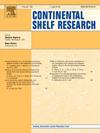Exploring the causal relationships between environmental factors and benthos distributions in an intertidal algal reef ecosystem via a structural equation model
IF 2.2
3区 地球科学
Q2 OCEANOGRAPHY
引用次数: 0
Abstract
Algal reefs are unique and valuable yet poorly understood marine ecosystems. The causal relationships between environmental driving forces and biotic community distributions in an algal reef ecosystem were assessed to fill large scientific gaps. Using a structural equation model (SEM) coupled with factor analysis, we established a well-fitted algal reef SEM. This model revealed that there were two subsystems, one operating primarily above the reef laminated substratum and the other beneath the surface. The crustose coralline algae (CCA) and non-CCA cover areas were affected, with an inverse trend between the two, by river inputs, as indicated by NH3-N concentrations, and by the seasonal rhythm of riverine NO3-N concentrations. The trends revealed spatial competition between the two algal groups. The CCA coverage and epifaunal gastropod density responded positively to the presence of pebble habitat. Notably, sand coverage and its variation did not hinder the coverage of the two macrophytes. However, the epifaunal gastropod and arthropod densities were negatively regulated by the sand coverage variability. The infaunal arthropod density was positively influenced by the sediment heavy metal content. Among the biotic communities, the non-CCA cover area negatively affected the infaunal polychaeta density. Furthermore, the increasing infaunal polychaete density increased those of sipunculans, bivalves, and arthropods, implying co-occurrence. This SEM revealed that riverine nutrients, pebble habitat type and sand coverage variability were significant environmental drivers in organizing the biotic communities in an algal reef ecosystem.
利用结构方程模型探讨潮间带藻礁生态系统中环境因子与底栖生物分布的因果关系
藻礁是独特而有价值的海洋生态系统,但人们对其了解甚少。评估了藻礁生态系统中环境驱动力与生物群落分布之间的因果关系,以填补巨大的科学空白。采用结构方程模型与因子分析相结合的方法,建立了一个拟合良好的藻礁结构方程模型。该模型揭示了有两个子系统,一个主要在礁层状基底上运行,另一个在地表下运行。水体NH3-N浓度和水体NO3-N浓度的季节变化规律对甲藻覆盖面积和非甲藻覆盖面积的影响呈反比趋势。这一趋势揭示了两种藻类之间的空间竞争。CCA盖度和掌下腹足动物密度对卵石生境的存在有积极响应。值得注意的是,沙地盖度及其变化并未影响两种大型植物的盖度。脚掌上腹足动物和节肢动物的密度受沙地覆盖度变异性的负调节。水生节肢动物密度与沉积物重金属含量呈正相关。在生物群落中,非cca覆盖面积对动物多毛体密度有负向影响。多毛类、双壳类和节肢类动物密度的增加表明它们是共生的。该扫描电镜显示,河流营养物质、卵石生境类型和沙层覆盖度变化是藻礁生态系统生物群落组织的重要环境驱动因素。
本文章由计算机程序翻译,如有差异,请以英文原文为准。
求助全文
约1分钟内获得全文
求助全文
来源期刊

Continental Shelf Research
地学-海洋学
CiteScore
4.30
自引率
4.30%
发文量
136
审稿时长
6.1 months
期刊介绍:
Continental Shelf Research publishes articles dealing with the biological, chemical, geological and physical oceanography of the shallow marine environment, from coastal and estuarine waters out to the shelf break. The continental shelf is a critical environment within the land-ocean continuum, and many processes, functions and problems in the continental shelf are driven by terrestrial inputs transported through the rivers and estuaries to the coastal and continental shelf areas. Manuscripts that deal with these topics must make a clear link to the continental shelf. Examples of research areas include:
Physical sedimentology and geomorphology
Geochemistry of the coastal ocean (inorganic and organic)
Marine environment and anthropogenic effects
Interaction of physical dynamics with natural and manmade shoreline features
Benthic, phytoplankton and zooplankton ecology
Coastal water and sediment quality, and ecosystem health
Benthic-pelagic coupling (physical and biogeochemical)
Interactions between physical dynamics (waves, currents, mixing, etc.) and biogeochemical cycles
Estuarine, coastal and shelf sea modelling and process studies.
 求助内容:
求助内容: 应助结果提醒方式:
应助结果提醒方式:


